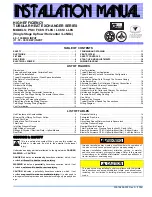
© 2014 CPT Autopilot Inc.
www.cptautopilot.com
Page 5 of 17
C. HOLD HEADING / STANDBY TOGGLE:
After a 1 minute warm up, flipping the switch to
Hold Heading
sets the pilot to the boat’s heading.
Hold the boat steady on desired heading about 30 seconds, engage clutch, then flip to
Hold Heading
.
Keeping the boat on heading for a longer period before flipping to
Hold Heading
will allow the pilot to
match your heading more closely.
When toggled to
Standby
, the pilot is on standby and the clutch can be disengaged for hand steering.
During the warm-up period the sensor heading will drift. Allow at least 1 minute for the pilot to warm-up
before flipping to
Hold Heading
, otherwise pilot will respond to drift and correct in one direction
once/second.
D. 1°/10° Buttons:
The push-buttons allow you to modify the target heading in 1° and 10° increments. The target heading is
modified after the button is released. Pressing and releasing once alters the target heading once, pressing
and releasing twice alters the target heading twice, pressing & releasing three times alters the target
heading three times, etc. Deadband settings affect how close the boat stays to the target heading. Due to
differences between boats, heading adjustments are not exact; check your ship’s compass after settling
on the new heading.
It is easy to lose track when pressing buttons multiple times, and you may overshoot the desired heading
if the boat is slow to respond due to currents or conditions; when the desired heading is reached simply
flip to
Standby
and then back to
Hold Heading
, or flip to
Standby
and steer to the new heading
manually.
*1° button response: When you push the 1° button, the new target heading will change by one degree,
but you won't see an immediate response until the boat strays out of the deadband range. The tightest
course-holding is when the deadband is set to the lowest setting, which allows a “dead-range” of about
2°s. If the bow of the boat strays more than about 1° port or starboard the pilot will take corrective action
with the 1° button; when the boat is within that range there will be no response.
E. Tacking:
Tack angles are approximate and will vary from boat to boat based on the magnetic environment & rudder
response. You will have to see which angle works best for your boat. In general, point as high as you can while
keeping good boat speed before tacking. Set deadband low to keep the boat close to the new tack heading.
Hold down the 1° and 10° buttons for the direction you wish to tack. Hold both buttons down for 5 seconds. Release buttons
to begin tack.
Port Tack: Push both the Port 1° and 10° buttons and release after 5 seconds.
Starboard tack: Push both the Starboard 1° and 10° buttons and release after 5 seconds
The rudder control must be properly set and the boat must have adequate speed and rudder response for the
tacking feature to work correctly. Keep an eye on boat response to avoid hitting the rudder stops; flip to
Standby and hand steer if boat does not respond to the tack well or gets stuck in irons. Making inadequate
headway, pointing too high, or having unbalanced sails can cause the boat to loose speed with poor response to
the rudder: go to Standby & disengage clutch to avoid hitting rudder-stops. If the boat is not tacking far
enough, the tack angle can be increased; if tacking too far the tack angle can be decreased. Depending on the
conditions and the boat’s momentum, the boat may carry slightly past the tack before correcting to the final
heading.
Adjusting the Tack Angle
: The tack angle is set at 100 degrees from the factory. To change tack angle:
Hold both the 10° Port and Starboard buttons down at the same time while turning the deadband knob to the new tack angle,
then release both buttons. The deadband dial has tack angle settings from 60°-120°.
Remember to return the deadband dial
to desired deadband setting afterwards.




































